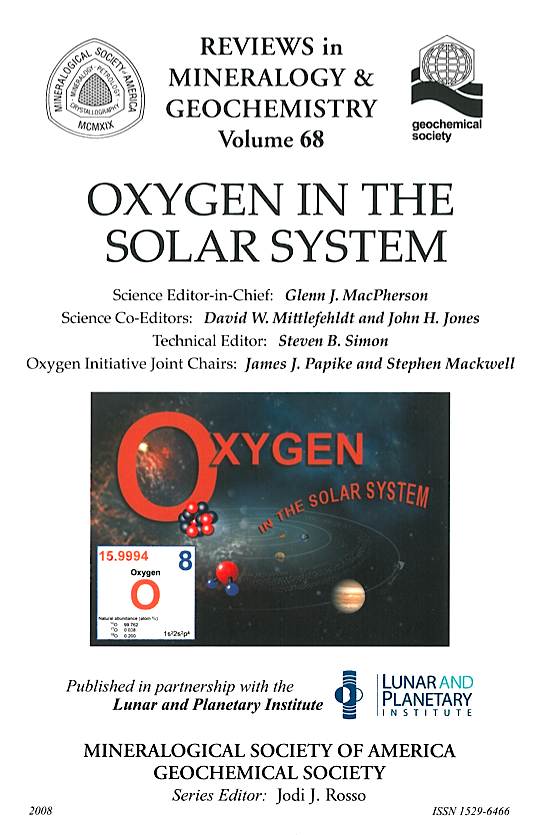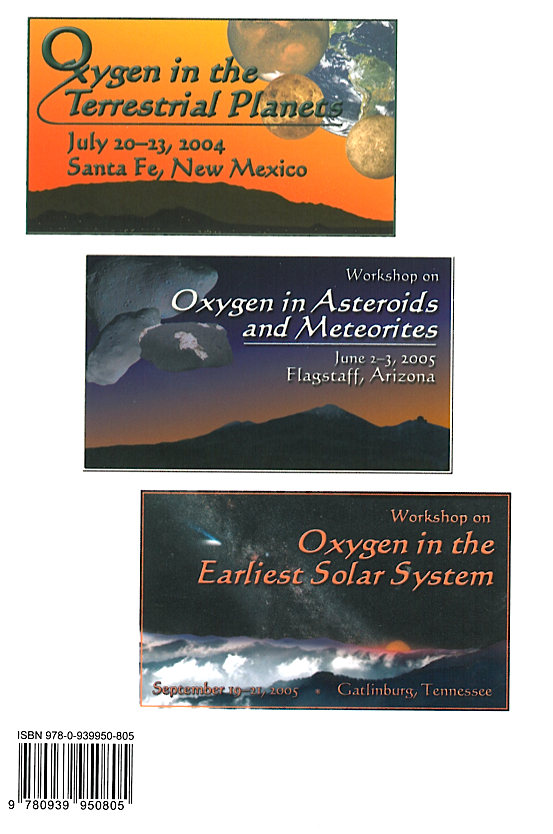

Mineralogical Society of America, Founded December 30, 1919
Order Publications Online (25% discount for MSA, CMS and GS members, except shipping)
MinPubs.org Pay-Per-View GeoScienceWorld Pay-Per-View


2008, i-xx + 598 pages. ISBN 0-939950-80-4; ISBN13 978-0-939950-80-5
Hydrogen may be the most abundant element in the universe, but in science and in nature oxygen has an importance that is disproportionate to its abundance. Human beings tend to take it for granted because it is all around us and we breathe it, but consider the fact that oxygen is so reactive that in a planetary setting it is largely unstable in its elemental state. Were it not for the constant activity of photosynthetic plants and a minor amount of photo dissociation in the upper atmosphere, we would not have an oxygen-bearing atmosphere and we would not be here. Equally, the most important compound of oxygen is water, without which life (in the sense that we know it) could not exist. The role of water in virtually all geologic processes is profound, from formation of ore deposits to igneous petrogenesis to metamorphism to erosion and sedimentation.
In planetary science, oxygen has a dual importance. First and foremost is its critical role in so many fundamental Solar System processes. The very nature of the terrestrial planets in our own Solar System would be much different had the oxygen to carbon ratio in the early solar nebula been somewhat lower than it was, because elements such as calcium and iron and titanium would have been locked up during condensation as carbides, sulfides and nitrides and even (in the case of silicon) partly as metals rather than silicates and oxides. Equally, the role of water ice in the evolution of our Solar System is important in the early accretion and growth of the giant planets and especially Jupiter, which exerted a major control over how most of the other planets formed. On a smaller scale, oxygen plays a critical role in the diverse kinds of physical evolution of large rocky planets, because the internal oxidation state strongly influences the formation and evolution of the core, mantle and crust of differentiated planets such as the Earth. Consider that basaltic volcanism may be a nearly universal phenomenon among the evolved terrestrial planets, yet there are basalts and basalts. The basalts of Earth (mostly), Earth's Moon, Vesta (as represented by the HED meteorites) and Mars are all broadly tholeiitic and yet very different from one another, and one of the primary differences is in their relative oxidation states (for that matter, consider the differences between tholeiitic and calc-alkaline magma series on Earth). But there is another way that oxygen has proven to be hugely important in planetary science, and that is as a critical scientific clue to processes and conditions and even sources of materials. Understanding the formation and evolution of our Solar System involves reconstructing processes and events that occurred more than 4.5 Ga ago, and for which the only contemporary examples are occurring hundreds of light years away. It is a detective story in which most of the clues come from the laboratory analysis of the products of those ancient processes and events, especially those that have been preserved nearly unchanged since their formation at the Solar System's birth: meteorites; comets; and interplanetary dust particles. For example, the oxidation state of diverse early Solar System materials ranges from highly oxidized (ferric iron) to so reducing that some silicon exists in the metallic state and refractory lithophile elements such as calcium exist occur in sulfides rather than in silicates or carbonates. These variations reflect highly different environments that existed in different places and at different times. Even more crucial has been the use of oxygen 3-isotope variations, which began almost accidentally in 1973 with an attempt to do oxygen isotope thermometry on high-temperature solar nebula grains (Ca-, Al-rich inclusions) but ended with the remarkable discovery (see Clayton 2008) of non-mass-dependent oxygen isotope variations in high-temperature materials from the earliest Solar System. The presolar nebula was found to be very heterogeneous in its isotopic composition, and virtually every different planet and asteroid for which we have samples has a unique oxygen-isotopic fingerprint.
The idea for this book originated with Jim Papike, who suggested the idea of a study initiative (and, ultimately, a published volume) focused on the element that is so critically important in so many ways to planetary science. He recognized that oxygen is such a constant theme through all aspects of planetary science that the proposed initiative would serve to bring together scientists from a wide range of disciplines for the kind of cross-cutting dialogue that occurs all too rarely these days. In this sense the Oxygen Initiative is modeled on the Basaltic Volcanism Study Project, which culminated in what remains to this day a hugely important reference volume (Basaltic Volcanism Study Project 1981). After obtaining community input and feedback, primarily through the Curation and Analysis Planning Team for Extraterrestrial Materials (CAPTEM) and the Management Operations Working Group for NASA's Cosmochemistry Program, a team of scientists was assembled who would serve as chapter writing leads, and the initiative was formally proposed to and accepted by the Lunar and Planetary Institute (LPI; Dr. Stephen Mackwell, Director) for sponsorship. A formal proposal was then submitted to and approved by the Mineralogical Society of America to publish the resulting volume in the Reviews in Mineralogy and Geochemistry (RiMG) series. Three open workshops were held as preludes to the book: Oxygen in the Terrestrial Planets, held in Santa Fe, NM July 20-23, 2004; Oxygen in Asteroids and Meteorites, held in Flagstaff, AZ June 2-3, 2005; and Oxygen in Earliest Solar System Materials and Processes (and including the outer planets and comets), held in Gatlinburg, TN September 19-22, 2005. The workshops were each organized around a small number of sessions (typically 4-6), each focusing on a particular topic and consisting of invited talks, shorter contributed talks, and ample time for discussion after each talk. In all of the meetings, the extended discussion periods were lively and animated, often bubbling over into the breaks and later social events. As a consequence of the cross-cutting approach, the final book spans a wide range of fields relating to oxygen, from the stellar nucleosynthesis of oxygen, to its occurrence in the interstellar medium, to the oxidation and isotopic record preserved in 4.56 Ga grains formed at the Solar System's birth, to its abundance and speciation in planets large and small, to its role in the petrologic and physical evolution of the terrestrial planets.
Glenn J. MacPherson, Washington, District of Columbia, USA
February, 2008
REFERENCES
Title Page
p. i
Copyright
p. ii
Frontpiece
p. iii
Dedication
p. iv
From the Editors & Preface
p. v - vi
Table of Contents
p. vii - xx
Chapter 1. Introduction
by Glenn J. MacPherson, p. 1 - 4
Chapter 2. Oxygen isotopes in the early Solar System - A historical perspective
by Robert N. Clayton, p. 5 - 14
Chapter 3. Abundance, notation, and fractionation of light stable isotopes
by Robert E. Criss and James Farquhar, p. 15 - 30
Chapter 4. Nucleosynthesis and chemical evolution of oxygen
by Bradley S. Meyer, Larry R. Nittler, Ann N. Nguyen, and Scott Messenger. p. 31 - 54
Chapter 5. Oxygen in the interstellar medium
by Adam G. Jensen, F. Markwick-Kemper, and Theodore P. Snow, p. 55 - 72
Chapter 6. Oxygen in the Sun
by Andrew M. Davis, Ko Hashizume, Marc Chaussidon, Trevor R. Ireland, Carlos Allende Prieto, and David L. Lambert, p. 73 - 92
Chapter 7. Redox conditions in the solar nebula: observational, experimental, and theoretical constraints
by Lawrence Grossman, John R. Beckett, Alexei V. Fedkin, Steven B. Simon, and Fred J. Ciesla, p. 93 - 140
Chapter 8. Oxygen isotopes of chondritic components
by Hisayoshi Yurimoto, Alexander N. Krot, Byeon-Gak Choi, Jerome Aléon, Takuya Kunihiro, and Adrian J. Brearley, p. 141 - 186
Chapter 9. Mass-independent oxygen isotope variation in the solar nebula
by Edward D. Young, Kyoshi Kuramoto, Rudolph A. Marcus, Hisayoshi Yurimoto, and Stein B. Jacobsen, p. 187 - 218
Chapter 10. Oxygen and other volatiles in the giant planets and their satellites
by Michael H. Wong, Jonathan I. Lunine, Sushil K. Atreya, Torrence Johnson, Paul R. Mahaffy, Tobias C. Owen, and Thérèse Encrenaz, p. 219 - 246
Chapter 11. Oxygen in comets and interplanetary dust particles
by Scott A. Sandford, Scott Messenger, Michael DiSanti, Lindsay Keller, and Kathrin Altwegg, p. 247 - 272
Chapter 12. Oxygen and asteroids
by Thomas H. Burbine, Andrew S. Rivkin, Sarah K. Noble, Thais Mothé-Diniz, Wliiam F. Bottke, Timothy J. McCoy, M. Darby Dyar, anf Cristina A. Thomas, p. 273 - 344
Chapter 13. Oxygen isotopes in asteroidal materials
by Iasn A. Franchi, p. 345 - 398
Chapter 14. Oxygen isotopic composition and chemical correlations in meteorites and the terrestrial planets
by David W. Mittlefehldt, Robert N. Clayton, Michael J. Drake, anf Kevin Righter, p. 399 - 428
Chapter 15. Record of low-temperature alteration in asteroids
by Michael E. Zolensky, Alexander N. Krot, and Gretchen Benedix, p. 429 - 462
Chapter 16. The oxygen cycle of the terrestrial planets: insights into the processing and history of oxygen in surface environments
by James Farquhar and David T. Johnston, p. 463 - 492
Chapter 17. Redox conditions on small bodies, the Moon and Mars
by Meenakshi Wadhwa, p. 493 - 510
Chapter 18. Terrestrial oxygen isotope variations and their implications for planetary lithospheres
by Robert E. Criss, p. 511 - 526
Chapter 19. Basalts as probes of planetary interior redox state
by Christopher D. K. Herd, p. 527 - 554
Chapter 20. Rheological consequences of redox state
by Stephen Mackwell, p. 555 - 570
Appendix: meteorites - a brief tutorial
by David W. Mittlefehldt, p. 571 - 590
Index 1 Subject Index, p. 591 - 596
Index 2 Meteorite Index, p. 597 - 598